July 2, 2010
Air Date: July 2, 2010
FULL SHOW
SEGMENTS
Sea Turtle Relocation
View the page for this story
It’s turtle nesting season along the Gulf Coast. But with the oil spill still ongoing, scientists fear turtle hatchlings will leave their nests and swim directly into the oily waters. So, conservation groups have devised a strategy to protect the young turtles: move their nests to the Atlantic coast. Host Jeff Young talks with David Godfrey, the executive director of the Sea Turtle Conservancy, about the detailed plan to save this year’s class of sea turtles. (06:00)
The Smallest Clean Up Crew
View the page for this story
The search is on for the best way to clean up oil in the Gulf of Mexico. Some companies want to release trillions of "super bacteria" into Gulf waters to eat the oil at a rapid pace. University of Louisville microbiologist and oil spill remediation expert Ronald Atlas talks with host Jeff Young about how likely this strategy is to succeed. (06:00)
Climate Bill Backup Plan
/ Mitra TajView the page for this story
With little time left on the legislative calendar, senators hoping to take action on climate change are abandoning controversial plans to limit emissions from all sectors of the economy. Living on Earth's Mitra Taj reports on the fallback option - putting a cap on just electric utilities, which are responsible for about a third of greenhouse gas emissions. (05:00)
The Evolution of Byrd
View the page for this story
Robert Byrd of West Virginia was the longest serving member of Congress in American history. Senator Byrd served 51 years in the U.S. Senate, and six years in the House. Reporter Ken Ward Jr. of the Charleston Gazette tells host Jeff Young how the coal state senator dramatically changed his opinions on environmental issues over the course of his career. (05:10)
Biggest Brains in Biggest Danger
View the page for this story
Just three deaths from the oil spill—that’s all it would take to push the sperm whales of the Gulf of Mexico to the brink. Hundreds are known to feed in the area of BP’s blowout. Host Jeff Young talks with marine mammal toxicologist Celine Godard-Codding and sperm whale expert Hal Whitehead about how the oil spill might affect these amazing whales, which have the largest brains and loudest voices in the animal kingdom. (07:30)
The Race Blind Heart
/ Regina Campbell-MaloneView the page for this story
Research shows that the body's acceptance of a new heart has nothing to do with the race of the donor or the race of the recipient. Living on Earth and Planet Harmony's Regina Campbell-Malone explains. (01:40)
How to Describe the Disaster?
View the page for this story
The BP oil disaster is a failure of technology and lexicology. The words that we use to describe the Gulf of Mexico disaster don’t begin to define the scope of the catastrophe. Is it a spill? A gusher? Host Jeff Young tracks the flow of words with Paul Payak from the Global Language Monitor. (04:15)
In Praise of Blackflies
/ Laurie SandersView the page for this story
Blackflies are much maligned, and that's something members of the Blackfly Breeders Association want to change. The Maine group has more than 1,000 members and, with tongue-in-cheek humor, campaigns to boast the virtues of the insect that most people love to hate. Laurie Sanders has our story. (05:30)
Music With a Solar Flare
View the page for this story
Most of us think of the sun as the provider of light and warmth. But what about sound? Professor Robertus von Fáy-Siebenbürgen, the head of University of Sheffield's solar physics team, translates the magnetic vibrations for human ears and tells host Jeff Young how the sun is a star musical performer. (05:30)
Show Credits and Funders
Show Transcript
HOST: Jeff Young
GUESTS: David Godfrey, Ronald Atlas, Ken Ward Jr., Celine Godard-Codding, Hal Whitehead, Paul JJ Payack, Robertus von Fáy-Siebenbürgen
REPORTERS: Mitra Taj, Laurie Sanders
SCIENCE NOTE: Regina Campbell-Malone
[THEME]
YOUNG: From Public Radio International - this is Living on Earth. I’m Jeff Young. Desperate measures to try to save a generation of baby sea turtles from the Gulf Coast oil.
[THEME]
GODFREY: The disaster that's unfolding right now in the Gulf is the greatest calamity for sea turtles that I've ever seen. It’s extremely frustrating because it's not something that we can fix right away.
YOUNG: Plus - how coal country’s senator for life changed his opinions on climate change.
BYRD: To deny the mounting science of climate change is to stick our heads in the sand and say deal me out. West Virginia would be much smarter not to say that but to stay at the table!
YOUNG: The unfinished final chapter of Senator Robert C. Byrd’s remarkable life. Those stories and more this week on Living on Earth. Stick around!
[THEME]
Sea Turtle Relocation
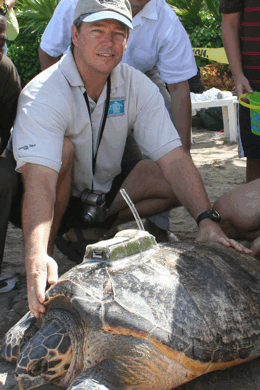
David Godfrey kneels with a sea turtle that has been tagged and will be monitored. (Sea Turtle Conservancy)
YOUNG: From the Jennifer and Ted Stanley studios in Somerville, MA, this is Living on Earth. I’m Jeff Young. The oil in the Gulf of Mexico is hitting the shores of Florida’s panhandle just as an ancient, epic event is unfolding on those beaches. Hundreds of female sea turtles are making their only trip out of the water to nest. Wildlife experts say the turtle hatchlings will likely die if they emerge into the oiled waters. So federal and state officials have made a bold decision to intervene on a massive scale. David Godfrey is executive director of the Sea Turtle Conservancy—a group working on this plan. Mr. Godfrey, welcome back to LOE.
GODFREY: Thank you, nice to be here.
YOUNG: So what’s the plan here, what do you hope to do?
GODFREY: Well in essence what we’re trying to do is save this year’s entire hatchling class of sea turtles form the north coast of Florida from emerging from their nests and swimming out into the gulf in order to meet certain doom because of all the oil that’s in that region.
YOUNG: How do you do it, how do you move all these nests? How many nests are we talking about?
GODFREY: Well, in that part of the Florida coast on average we probably see in the neighborhood of 700 nests, and, of course, each nest has approx 100 eggs in it, so 70,000 or more eggs are going to be moved. A number of things are being done to avoid all of the potential negative impacts of this. And, the things that we’re concerned about, those include potentially tinkering with the sex ratio of the hatchlings developing.
YOUNG: How would it change the sex ratio just by moving the eggs?
GODFREY: Because, the sex of each hatchling is determined by the temperature at which the egg incubates. If you’re moving them all to a particular region, number one you’re changing the temperature they would have incubated at under normal circumstances, and, you’re sort of putting all your eggs in one basket - so that they might all be incubating at the same temperature cause they’re in the same location, thereby creating almost all one sex. So the eggs are going to be allowed to incubate where they were deposited for almost the entire incubation process, which is about 60 days, and at that 50 day mark the nest will be carefully dug up, the eggs removed and placed into a specialized container that is given a layer of sand around the outside directly from the nest, so they’re still within the same sand that they were in before.
And, each one of those individual containers will be carefully transported to a hatchery facility on the east coast of Florida and then as the hatchlings emerge in the container they will immediately be released at the first night fall in a variety of different locations so that there’s not this massive flood of hatchlings all leaving the beach and entering the water at the same location which might tend to attract predators. So we want to avoid that as well.
YOUNG: What might this do to the turtles and their habits of where they end up nesting in the future? Will those hatchlings, will they then return to that beach where they were released, or will they try to get back to the beach on the Gulf Coast?
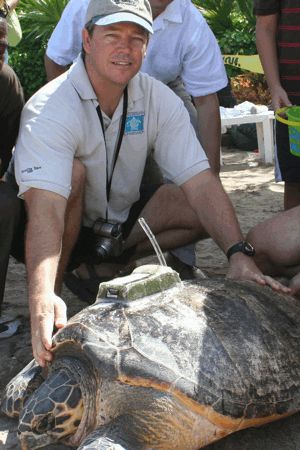
David Godfrey with a sea turtle that has been tagged and will be monitored. (Sea Turtle Conservancy)
GODFREY: Well, certainly we hope that they will go back to their natal beach, the beach where they are supposed to be nesting on the Gulf Coast, and the protocol that’s being used to move these nests, we hope, is giving them the best chance of doing jut that. It appears that sea turtles can use the earth’s magnetic field to determine where they are at any given moment and use that information to navigate. Well, in order for that to happen, they must have some sort of internal map that tells them where they are, and it’s unknown to science and to biologists exactly when that map is created.
Is it information that’s passed on genetically, so whether you move them or not, the information is there? Or, is it something that occurs during the incubation process? We don’t know exactly, but by leaving them there as long as possible, leaving them within the sand from that beach, we think, gives them the greatest chance of not having their, sort of, navigation cues for that map disturbed in some way.
YOUNG: This sounds like a big gamble, but one where you’re looking at a series of choices ranging from really bad to somewhat less bad.
GODFREY: I think that’s a fair way to look at it. There are potential risks with the relocation, but we think that the plan that’s in place minimizes every one of those risks. It is all so true that our organization is generally very much opposed to relocation turtle nests.
YOUNG: So, ordinarily you’d be opposed to relocating these nests?
GODFREY: That’s right. I mean that simply is not the way to recover sea turtle populations. The real way is to address threats that turtles are facing, whether it’s artificial lights or inappropriate coastal development, we need to address and reduce each one of those threats in order for sea turtles to survive and relocating nests is simply hiding from the real problem. Well, the reality because of this spill is we can’t address that problem any time soon; it’s the greatest calamity for sea turtles that I’ve ever seen. The Sea Turtle Conservancy literally was the first organization in the world formed to protect sea turtles. And, to see all that work and all of our progress jeopardized by this one incident, its heartbreaking and frustrating and we’re just doing what we can at this movement to give them the best chance of survival.
YOUNG: David Godfrey is executive director of the Sea Turtle Conservancy. Thank you.
GODRFEY: Thank you.
Related links:
- Sea Turtle Conservancy
- Click here for more information on the turtle relocation plan.
- Click here for more information on the 2010 hypoxic zone forecast for the Gulf of Mexico.
- Click here for more on the link between the oil spill and hypoxia.
The Smallest Clean Up Crew
YOUNG: Well, a number of entrepreneurs say they have an answer for the oil in the Gulf: seed the ocean with trillions of ravenous “super bacteria” that eat hydrocarbons. These companies are pitching their lab-tested superbugs all around the Gulf coast—one even testified before congress. But a leading expert in bioremediation is deeply skeptical. Microbiologist Ronald Atlas, at the University of Louisville, pioneered the use of microorganisms and their enzymes to clean up oil spills. Professor Atlas says, unfortunately, there’s no quick fix.
ATLAS: There have been decades of looking for a super bug; there have been genetically engineered and patented oil-degrading bacteria. You can do it in the laboratory but when you come to the real world, it fails.
YOUNG: And the difference between the lab and field tests, why do you see such different results between those two experiences?
ATLAS: In the field, as soon as the oil comes out of the well, it’s being colonized by indigenous or native bacteria. So that if you’re trying to add a foreign bacterium, you not only have to worry about whether it can degrade the oil, but can it displace and get rid of the organisms that are already colonizing all over the oil droplets?
YOUNG: Now, you speak with a great deal of authority on this issue because you’ve worked on a lot of spills—how many spills have you worked on?
ATLAS: Oh quite a number. I’ve worked on the Ixtoc 1 well blowout, which until now was the largest in the Gulf region, the Exxon Valdez, the Amico Cadiz, the Kuwait oil spill, smaller spills in the jungles of the Amazon in Ecuador.
YOUNG: When you were working on these earlier spills, say the Valdez spill, did you get these sales pitches from companies saying, ‘here, use my superbug and we can clean this up for you?’
ATLAS: Yes. One of the jobs that I had for Exxon and the US EPA was to sit at a desk and have one sales person after another come in and throw things at me. Everything from orange peels and lemon peels, which, supposedly were bio-remediation agents because you couldn’t smell the oil when you threw them on, to endless bacterial sales pitches and yes it reached Congress and the White House at that point and I had to go into Washington and defend the science against the political onslaught of the bug salespeople. It’s absolute déjà vu.
YOUNG: Well, what is going on with the bacteria in the Gulf with the oil, what do you think is going on now?
ATLAS: Well, clearly there are bacteria in the Gulf that are able to degrade oil, and they are colonizing the oil droplets as it comes out of the well and beginning to grow. And it’s in the area of the Gulf, where this spill is occurring, there are 63 natural seeps, there’s 20 million gallons a year of oil that naturally enter this region of the Gulf, and, for bacteria, that’s a wonderful food source. They don’t degrade the oil instantly, it’s a slow process, taking weeks, months, even years for some of the different compounds in the oil to go away. But, the bacteria that naturally occur there are able to degrade the oil and eventually they’ll get rid of most of the oil components.
YOUNG: So, what should we be doing then?
ATLAS: I think right now we try to continually clean up the oil by physical containment and removal. When that fails, we’re going to look at that natural bacterial weathering process and we’re going to ask the question, can we speed it up by adding a nitrogen and phosphorous containing fertilizer, much like what you do in your garden.
YOUNG: When you talk about adding nutrients to this part of the Gulf, don’t they already have too many nutrients? That’s what causes that low oxygen dead zone in the Gulf. Can you add nutrients, fertilize, without making that lack of oxygen worse?
ATLAS: Yes, most of the bacteria that rapidly degrade oil do consume oxygen, and, what we saw in Exxon Valdez was a depletion of about 30% when very rapid degradation occurs. But they’ve not brought it down to a dead zone that would kill fish, so we see a depression, but as long as the water is flowing, we don’t see a total elimination of oxygen.
YOUNG: And, how much benefit can we expect from this approach, how much good might this do us?
ATLAS: In the Exxon Valdez spill case, which was the largest use of bio-remediation ever, we found we could speed it up two to five times, which means if you were looking at a decade of impact you could reduce it to two to five years. So the question becomes if it was going to be a decade, is speeding it up worth the effort? And generally, I’d argue, it is.
YOUNG: So, this might be especially beneficial for areas that are really hard to clean otherwise, right?
ATLAS: It certainly looks like the marshes represent an area where bio-remediation may be needed, and certainly, if any of these storms move the oil into the bays and it becomes trapped in other sorts of shorelines, that’s where I’d expect bio-remediation to be most useful. The good news is that the oil will naturally weather, the ecosystem will eventually recover, and the downside is it’s not going to happen instantly. We’ve just not found the magic bullets that will make this oil go away tomorrow.
YOUNG: Dr. Ronald Atlas, microbiologist and expert on bio-remediation and oil spills, thank you very much.
ATLAS: Thank you.
YOUNG: And, by the way, scientists monitoring the dead zone that forms around the Mississippi delta each year, just put out their forecast for this year. They expect the dead zone to cover some 77 hundred square miles, an area the size of New Jersey. And that’s not factoring in possible effects of the oil, which will likely lower oxygen levels in some waters even further. There’s more about this and all of our special Gulf coverage at our website, loe.org.
[MUSIC] Bill Frisell “Finger Snappin And Toes Tappin” from Ghost Town (Nonesuch 2000).
YOUNG: Just ahead - how the longest serving Senator changed his mind about old King Coal - keep listening to Living on Earth!
[CUTAWAY MUSIC] Lee Ritenour: “Lay It Down” from 6 String Theory (Concord Music Group 2010).
Related links:
- Bioworld
- Center for Health Hazards Preparedness at University of Louisville
Climate Bill Backup Plan
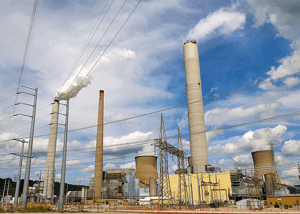
A 3,000 MW coal-fired power plant in West Virginia. Emerging Senate climate legislation could place a cap on just the utility sector. (Photo: haglundc)
YOUNG: It’s Living on Earth, I’m Jeff Young. It’s crunch time on Capitol Hill for energy and climate change. President Obama called senators to the White House to try to find some bipartisan agreement. Democratic leaders want some sort of cap on greenhouse gases; Republican leaders call that a national energy tax. The White House meeting might have opened a new middle path: a plan to limit emissions from just one part of the nation’s energy economy, power plants. Living on Earth’s Mitra Taj explores where that path might lead.
TAJ: When it comes to energy and climate change, the Senate has no shortage of ideas. Half a dozen proposals have been introduced, and many senators hoped the recent talk with President Obama would clear up which one should lead the way. Instead, the bipartisan group of 23 senators returned to Capitol Hill with few specifics:
DORGAN: …There wasn’t a decision point at this meeting, it was a roundtable discussion…
MURKOWSKI: Well, it was a good conversation- ‘cause I think it’s fair to say there was no consensus about what the path forward is…
LIEBERMAN: The president was very strong that this is the moment to aim high.
CARPER: He urged us to aim high, and everybody had a chance to say their piece- he would interact with people as they would say their piece. We came back in the end and he says okay, this is what I think I’m hearing.
TAJ: Senator Tom Carper, a Delaware Democrat, said that while the President didn’t lead the group to any particular policy, it became clear that one approach to climate change would be more politically viable than others.
CARPER: I sensed a willingness to address carbon dioxide with respect to utilities.
TAJ: Limiting emissions from just electric utilities is a new compromise possibility. It differs from the House climate change bill passed a year ago that would cap emissions from all sectors of the economy. Greenhouse gas polluters would buy and sell pollution permits with one another to find the cheapest way to keep their emissions under a declining target. But Paul Bledsoe, an analyst with the Bipartisan Policy Center, said a complimentary senate bill, sponsored by John Kerry and Joe Lieberman, hasn’t found much support.
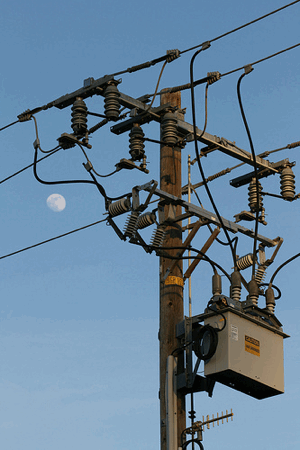
Electric utilities account for roughly one third of greenhouse gas emissions. (Photo: Philip Bouchard)
BLEDSOE: I think there has been a sense for some time that it was going to be difficult to pass an economy-wide measure in the U.S. Senate. And, it looks right now that the most aggressive bill that could emerge from the Senate on climate would be one that put emissions limits on the electric utility industry alone.
TAJ: Senators Kerry and Lieberman said they’d be willing to consider starting with a cap on just utilities, and leave transportation and manufacturing for later. Bledsoe said as far as compromises go, it’s not a terrible one to make. For one, the coal-burning utility sector is responsible for about a third of U.S. greenhouse gas emissions.
BLEDSOE: So it’s by far the biggest piece of the U.S. domestic emissions reductions. And every successful cap has started with the utility sector. California first regulated the utility sector, Europe first regulated the utility sector. So, capping emissions from power plants first seems to be a very logical step in beginning to reduce emissions from the whole economy.
TAJ: The power plant association Edison Electric Institute isn’t ready to comment on limiting emissions from only its industry. Some utilities have long been opposed to a cap, but others, like Duke Energy, are in favor.
WILLIAMS: We’re willing to do that. I would say, in essence, half a loaf is better than no loaf at all.
TAJ: Tom Williams is spokesman for Duke Energy, one of the biggest utility companies—and biggest single emitters—in the country, and one that’s been active in supporting cap-and-trade legislation. Williams says cap and trade worked for the industry before—cutting sulfur dioxide emissions during the acid rain program of the early 1990s. He says a similar system can work for the industry with carbon dioxide.
WILLIAMS: We’re used to how these markets work, and we’re able to, you know, with the cap and trade approach, we’re able to meet very tough regulations at costs much less expensive than we were otherwise able to meet them. So we’ve been there before, we’ve made these types of systems work, and we’re a good industry to start with.
TAJ: Focusing on just one sector of the economy probably won’t deliver the amount of emissions cuts the President is hoping for. He said he wants reductions of 17% by 2020. But Robert Stavins, a Harvard economist, says it’s unlikely that target can be achieved from capping just the utility sector.
STAVINS: Rather than achieving something on the order of 17% reductions by 2020, instead, you’d probably find reductions of about one third of that.
TAJ: A third of the President’s goal is quite a step back for many green groups who were pushing the President to make even deeper cuts. But Steve Cochran, director of the Environmental Defense Fund’s national climate campaign, says it’s better than the energy-only bills that some senators are pushing. Those proposals would support renewable energy without mandating a limit on emissions.
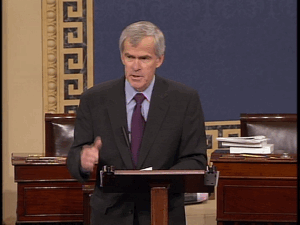
Senator Jeff Bingaman (D-NM) has written bipartisan energy bills and could be the author of new legislation to target emissions restrictions on power plants.
COCHRAN: Zero is not a good outcome, and that’s one of the options on the table. So if somebody wants to pass an energy-only bill, they’ll certainly do so without our support, they may do it over our opposition if that’s what they decide to do.
TAJ: For all the talk about a utility-only cap, a proposal has yet to be written. Senator Jeff Bingaman, chairman of the Senate Energy and Natural Resources Committee, recently said he’s working on one, but is unsure there’ll be enough support for him to introduce it. Energy and climate proposals will be tied together with an oil spill bill and taken up by the full Senate in mid-July.
For Living on Earth, I’m Mitra Taj in Washington.
The Evolution of Byrd
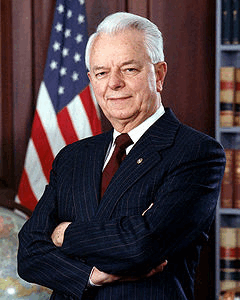
West Virginia Robert Byrd (D) was the longest serving senator in American history. (Wikipedia creative commons)
BYRD: My name is Robert C. Byrd. I am a United States Senator and I am an American.
YOUNG: America lost a piece of living history with the death of its longest serving senator. West Virginians, like me, felt a deeper sense of loss. Senator Byrd, with his white hair and red vest, was as much a symbol of our state as the red cardinal and the black bear. His loyalty to West Virginia and the U.S. constitution never wavered – but Senator Byrd was willing to change. He changed his views on race and war and after decades of defending the coal industry, Senator Byrd was changing again, in his final years. Reporter Ken Ward Jr. at the Charleston Gazette was one of the first to take note.
WARD: In the mid- to late 90’s, Senator Byrd was among of those who pushed to block the United States’ ratification of the Kyoto protocol, which would have limited greenhouse gas emissions. Senator Byrd was very clearly a friend of coal, and did everything he could to protect and defend that industry.
YOUNG: And when it came to mountaintop removal mining, Senator Byrd in the 90s, he was right there in the trenches with the mining industry.
WARD: Senator Byrd fought very hard in the Senate, he failed in this effort, but he fought very hard in the Senate, to rewrite portions of the Clean Water Act to specifically approve valley fields and allow coal operators to continue burying streams.
Senator Byrd made it clear that anything that was going to curtail or limit mountaintop removal, he was going to stop. Senator Byrd referred to environmentalists as, I’m paraphrasing here, head-in-the-clouds individuals that would have us live in a utopia among old-growth forests, but didn’t have any realization of the economic impact of the coal industry and the fact that the coal industry puts food on the tables of people in his home state.
YOUNG: And this was not that long ago, this was—
WARD: 1999.
YOUNG: So, here in recent years, however, we saw a very different kind of rhetoric and message coming from Senator Byrd. What was that about?

West Virginia Robert C. Byrd (D) was the longest serving senator in American history. (Wikipedia creative commons)
WARD: One thing to keep in mind in understanding this, it really was a transformation in progress of his thinking. In December of last year, he issued a long statement and gave a speech, encouraging the coal industry to embrace the future, to not pretend climate change wasn’t happening and that greenhouse gas emissions weren’t affecting the climate, to seek some sort of middle ground on mountaintop removal issues.
BYRD: West Virginians may demonstrate anger towards the Environmental Protection Agency, the EPA, over mountaintop removal mining, but we risk the very probable consequence of shouting ourselves out of any productive dialogue with the EPA and our adversaries here in the Congress.
YOUNG: Ken Ward, that sounds to me like it’s a rebuke of what other West Virginia political leaders were doing at the time.
WARD: Oh, it absolutely was a direct rebuke of Governor Manchin, of Congressman Rahall, of Senator Rockefeller, all of whom were engaged in this increasingly extreme rhetoric, whereby, any small step towards trying to get a grip on the impacts of the coal industry was immediately attacked, very vocally, as anti-jobs. And Senator Byrd was not just speaking to the people of West Virginia, but I think, was speaking to his fellow political leaders saying, ‘this isn’t going to get us anywhere. This isn’t the way to try and deal with these issues.’
YOUNG: And here’s another excerpt from that speech:
BYRD: To be part of any solution one must first acknowledge a problem, to deny the mounting science of climate change is to stick our heads in the sand and say ‘deal me out.’ West Virginia would be much smarter not to say that, but to stay at the table.
YOUNG: That’s a remarkable statement on climate change from someone who, not that long ago, was working very hard to block any action on climate change.
WARD: And, just as remarkable as that statement is, one of Senator Byrd’s last roll call votes in the United States Senate, was a vote against the Murkowski resolution to over-turn EPA’s findings that climate change was a threat to public health and welfare. And among his reasons for doing so, he said the Murkowski resolution was ignoring science. And Senator Byrd said West Virginians ought not to ignore the science of climate change--it’s really remarkable.
YOUNG: One of his last big messages to West Virginia was a plea for a reasoned dialogue. Do you see any indication that people there heard him?
WARD: In West Virginia I think you no longer have anybody who is a major elected official or major political figure who is really interested in confronting these issues in a meaningful way. He was really a lone voice on this, and he was also now becoming almost a referee on these issues with climate where he was saying, ‘Ok now folks, just standing around and yelling at each other and calling EPA names isn’t going to get us anywhere. Let’s talk together and find ways forward.’ And now we don’t have that voice helping us do that.
YOUNG: Ken Ward Jr. at the Charleston Gazette, thank you very much.
WARD: Thank you, Jeff.
[MUSIC] Pickin On Series “Independence Day” from Pickin On Bruce Springsteen Vol2 The Bluegrass Tribute (CMH Records 2003).
Biggest Brains in Biggest Danger
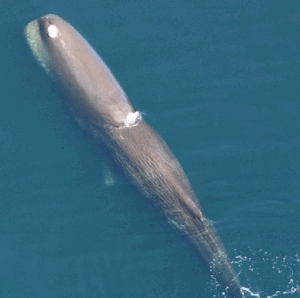
Sperm whales in the Gulf of Mexico are threatened by the BP oil blowout. (NOAA)
YOUNG: NOAA, the National Oceanic and Atmospheric Administration, just sent a research vessel to learn how the BP oil disaster is affecting the only endangered marine mammal in the Gulf – the sperm whale. A NOAA report estimates about 1600 sperm whales live in the Gulf. On June 15th government scientists found the carcass of a young whale about 80 miles south of the BP wellhead. Texas Tech toxicologist Celine Godard-Codding warns that just a few deaths could tip the balance.
CODDING: The 2009 report done by NOAA mentioned that if there are about three animals that die beyond normal mortality happening, for example if it’s due to the oil spill, there would be a cause of great concern for that population.
YOUNG: So just three, three deaths above the normal mortality would mean what, that they’re in trouble?
CODDING: That’s correct. Three deaths due to human causes.
YOUNG: You know, when I was looking at that report from NOAA, there’s a map that shows you where the sperm whales have been spotted over time in the Gulf, and what stands out to me when I look at that image is the overlap between many of those sightings, and where we now know the oil is in the Gulf.
CODDING: There’s about 260-280 whales that appear to be sighted in that area that’s very close to the origin of the oil spill on a regular basis.
YOUNG: What does that mean for sperm whales if they come into contact with the oil. How might the oil affect them?
CODDING: This oil spill disaster is of a scale that we haven’t seen before, and there is a potential for direct exposure to the whales, maybe if they breathe the fumes. But, there is also the potential for toxic effects or negative impacts occurring not right away, but also in terms of long-term chronic exposure to oil and the potential effects that may cause.

Sperm whales in the Gulf of Mexico are threatened by the BP oil blowout. (NOAA)
YOUNG: That’s Marine Toxicology Professor Celine Goddard Codding, at Texas Tech.
Biology Professor Hal Whitehead, at Nova Scotia’s Dalhousie University, shares her concern. After 30 years studying sperm whales, Professor Whitehead is still in awe each time he sees them.
WHITEHEAD: You see this massive, massive head, which is the sonar system, and then this strange wrinkled body- they look completely weird! And, of course, they live in this strange world which we know very little about -- the deep ocean. And yet, on the other hand these animals, they’re mammals, and you can see them stroking each other, touching each other, nuzzling each other, you know almost kissing each other, they have a very tender, deep and important social life.
(SOUND OF WHALES CLICKING)
YOUNG: Professor Whitehead records the whales’ vocalizations, which vary depending on where they live and what they’re doing.
WHITEHEAD: What we’re hearing is a large number of sperm whales clicking. Most of the clicks you hear are from sperm whales using the clicks as a sonar system. The front quarter of their body is this sonar system, and it produces the most powerful sound in the animal world. But they also use the clicks for other purposes, and this is one of the ways, perhaps one of the main ways, they communicate with each other. And we think these are maybe a large and important part of the glue that puts their societies together. It’s an extraordinary system.
YOUNG: There are a lot of superlatives attached to the sperm whale. They’re first in a lot of things, aren’t they?
WHITEHEAD: They, they are. I call them the animal of extremes, and for a biologist, it’s a puzzle why this animal which has this powerful sonar system, also has the largest brain on earth? Why is it also the animal in which the males and females are most separated on earth? So most of the adult males are in Arctic or Antarctic waters, whereas most of the adult females are in the tropics and sub-tropics. Why is it they still take out of the ocean an amount which is roughly comparable to all the human fisheries?
YOUNG: You’re kidding me! The actual amount that sperm whales eat is on par with what we take out of the ocean?
WHITEHEAD: Well, not quite. They mainly eat squid. And we mainly eat fish. Now they eat some fish, and we eat some squid, but basically if you add up the amount that we eat and the amount that they eat, it’s about the same.
YOUNG: We hunted these whales primarily for the oil, and then we discovered this new thing called ground oil, and that kind of killed the market for hunting whales for oil. The history of oil and whales has been intertwined for a long time, hasn’t it?
WHITEHEAD: It has, yes. I mean the Quakers of Nantucket of the late 18th century, in some ways they were the BP of that era -- and they caused a lot of environmental damage too. But as you say, when people found the ground oil coming out of that field in Pennsylvania, then that changed the balance, and in some ways it let the sperm whales off the hook.
YOUNG: What is at risk in the Gulf of Mexico, what’s your concern with what’s going on there?
WHITEHEAD: My concern is that we have a moderately well studied population of sperm whales. What we know about them is that they’re an important part of the life of the Gulf of Mexico, because they’re big and important predators. They’re largely separated from other sperm whales. They have their own way of doing things.
(SOUND OF SPERM WHALES CLICKING)
WHITEHEAD: The different areas of the Atlantic have somewhat different dialects. So, the Gulf of Mexico has a fairly distinctive dialect, which is different from the sperm whales in say the eastern Caribbean, or in the Sargasso Sea, out off the east coast of the states.
YOUNG: A southern accent, maybe?
WHITEHEAD: A southern accent. And the important thing, I think, to me, is that that’s the bit of their behavior that we can most easily record and study. I think it’s very likely that those sperm whales in the Gulf of Mexico have a bunch of other culturally determined behavior, which is really important to them, which determines their identity, how they relate to their environment. So just as we try and preserve the diversity of human languages, so it’s important for the sperm whales, and the other whale species, to preserve the diversity of cultures.
YOUNG: And, you think whales are developing culture?
WHITEHEAD: Well, I think, it’s not so much they’ve been developing it; I suspect they’ve had it for a lot longer than we have. Until the modern human came along, the extraordinary modern human, if you were looking for culture on earth, you’d find it in the oceans. As with humans, with these animals we should value their cultural diversity. The diversity of knowledge as represented by what’s held in different parts of the Atlantic including the Gulf of Mexico, is a really important resource for the whole sperm whale population. And if they’re gone we’ve lost that, forever.
YOUNG: Professor Hal Whitehead, thank you very much for your time.
WHITEHEAD: You're very welcome.
YOUNG: Biology Professor Hal Whitehead at Dalhousie University. There’s more about his work and NOAA’s report on the Gulf sperm whales at our website, loe dot org.
Related links:
- Dr. Godard-Codding’s research
- Dr. Whitehead’s research
- NOAA report of dead sperm whale in Gulf
- Click here for more information on Sperm Whale distribution
[MUSIC] Paul Winter “Lullaby from The Great mother Whale” from Callings (Earth Music 1980).
YOUNG: Coming up: learning to love and celebrate a bloodsucker – that’s NOT in the Twilight saga - That’s just ahead on Living on Earth.
[CUTAWAY MUSIC] “ Blues Latino” from Multi-Dimensional Warrior (Sony Legacy 2008).
The Race Blind Heart

YOUNG: It’s Living on Earth, I’m Jeff Young. In 1967, doctors performed the first heart transplant, and, the U.S. Supreme Court fully legalized interracial marriage. Now in 2010, doctors have finally shown that the heart never segregates. Living on Earth and Planet Harmony's Regina Campbell-Malone brings us this note on emerging science.
[THEME]
CAMPBELL-MALONE: Interracial couples have known for millennia that the heart is colorblind. But a new study of heart transplants tells us that the human heart itself functions very well, even across color lines. Researchers at Johns Hopkins University, examined medical records from over 20,000 transplant patients and found that the one-year survival rates were equal whether donors and recipients were the same race or not.
This suggests that donor-recipient race matching will not improve transplant success in the short term… meaning that an African American patient waiting for a heart is not limited to the relatively small pool of African American donors.

But what we don’t know is why African American transplant recipients still have lower survival rates in the long term compared to other races.
Five years after heart transplant surgery, African American patients have a survival rate that is about 10% lower than Hispanics and whites. While this study ruled out race matching as a root cause for short term survival differences, other factors including health insurance status, education, hypertension and gender mismatch, may be contributing to the disparity. Researchers still have a lot to learn, but the heart of the matter is that when it comes to heart transplants, we're all the same on the inside. That’s this week’s note on emerging science. I'm Regina Campbell-Malone.
YOUNG: Planet Harmony invites everyone to the environmental discussion. Log in and send your stories, audio, video to our site at myplanetharmony.com.
Related link:
Visit Planet Harmony to join the environmental discussion
[MUSIC] J Boogie “Try Me” from Try Me Remixes (Om records 2003).
How to Describe the Disaster?
YOUNG: Millions - maybe billions - of words have been written about BP’s runaway oil well. Yet words still fail us—we still lack the right term for what’s happening in the Gulf. So we turn to Paul JJ Payack for guidance. He’s President of the Global Language Monitor in Austin, Texas, where he tracks changes in the language, including the words most often used to describe the oil in the Gulf.
PAYAK: Overwhelmingly, overwhelmingly, the top word is oil spill, which is sort of a disappointment. Many times when you have new events in a language, the language leads the event. You can actually… there are new words that pop up in profusion.
YOUNG: Uh huh.
PAYAK: And, in this case, we haven’t seen that many new words. What we’ve seen is the old way to describe an oil spill. The Exxon Valdez has a crash, spills the oil out, and that’s a spill. But this is different; this is a lot different than a spill.
YOUNG: Because a spill connotes a fixed amount that spilled from a container into where you don’t want it. That’s not what’s happening here at all.
PAYAK: In our case, we’re not talking about a spill, we’re talking about an oil field that’s estimated at 3, 4, 5 billion barrels erupting, but we still refer to it as a spill.
YOUNG: What other words are people trying out, here?
PAYAK: Ok, they’re trying out things like a disaster, the gulf oil spill disaster. Another one that’s pretty high up is Valdez, from the Exxon Valdez, okay. And then we have blowout, and that’s been used in the oil industry for probably 100 years now. It’s giving lots of rise to people talking about an apocalypse, and things of that nature.
YOUNG: I’ve come across the terms oilpacolypse and oilmageddon.
PAYAK: Yeah, and again, that’s like the snowpocalypse in Washington DC, right, snowmageddon. That was very widely adopted by the media, so we’re looking for things like that, we’re looking for those clever formations but they haven’t really taken hold. Other words that people are using are gusher, plume, another one that we found in the foreign press was torrent, a torrent of oil.
YOUNG: Torrent, that’s good because it’s pouring forth, yeah. But again, spill is used 1000 times more than torrent is used. Gusher is a pretty good one. It’s accurate, I think. However, when you think of a gusher, you think that’s a good thing. Hey, we struck it rich! We hit a gusher!
PAYAK: Right. And you always have to explain that the gusher isn’t necessarily good. When people are looking at a gusher, all that oil, and yeah as it’s been said, is being wasted.
YOUNG: The incident, however, is giving us a lot of new and interesting terms. Top kill, junk shot, things like that. What are you learning from tracking that kind of language that’s emerging?
PAYAK: That’s very interesting. Top hat was number one, and then blow out, and then top kill, and then torrent as a technical term. Now number 5 is really interesting to us. Macondo blowout.
YOUNG: Macondo. Why is Macondo being used with this BP incident?
PAYAK: Well, first of all it’s the Macondo field. When you buy a track, you name it, and evidently this was named the Macondo track. Now, it’s from a book “100 Years of Solitude,” by Gabriel Garcia Marquez, and that is a book, that you could look at it, it’s about a faded town, some may say cursed…
YOUNG: Yeah, Macondo gets wiped away at the end of the book.
PAYAK: It gets wiped away, and during the multiple generations that you read about, there is some happiness and joy, but there is this insurmountable list of things that need to be overcome, horrendous things. Let me read from the end of the book. “It was as if God had decided to put to the test every capacity for surprise and was keeping inhabitants of Macondo in a permanent alternation between excitement and disappointment, doubt and revelation, to such an extreme that no one knew for certain where the limits of reality lay.”
YOUNG: Gabriel Garcia Marquez could have been writing about the Gulf today- it’s amazing!
PAYAK: Certainly sounds that way. Certainly sounds to reverberate with this whole end of “100 Years of Solitude,” and the summation of what’s going on.
YOUNG: Macondo, wow. Thanks very much.
PAYAK: Ok, talk to you later. Thanks a lot.
YOUNG: Back tag: - Paul JJ Payack is chief word analyst with the Global Language Monitor. Don’t you be speechless - let us know what word or phrase you think best describes the oil mess in the Gulf. Send your words our way - to our Facebook page at PRI’s Living on Earth - or comments at loe.org – or our listener line at 800-218-9988.
[MUSIC] Los Aragon “Macondo” from Juguito De Frutas (Musart – Balboa 2009).
In Praise of Blackflies
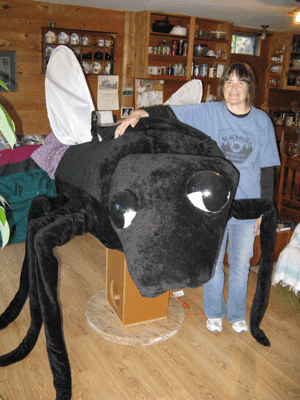
Marilyn Dowling and her housemate, Bloody Merry (Photo: Laurie Sanders)
YOUNG: People love to hate blackflies. They feed on the blood of animals – including people - and many states have programs to eradicate them. But one group in Maine believes if you can’t beat ‘em, join ‘em. Laurie Sanders has our story.
SANDERS: If you really wanna know what Maine is like, Marilyn Dowling says, you’ve got experience it in blackfly season.
DOWLING: The East Machias River is one of the best blackfly hatcheries around. It’s clean water, it’s flowing briskly, and we have the most incredible swarm here every year.
SANDERS: And she’s right. Within moments, a cloud of blackflies starts to gather around us. They’re all females, each one seeking a blood meal to enrich her eggs that she will soon be laying.
DOWLING: I notice you have a few bites today. You have two good ones right behind your ear. That’s a status symbol, having the two bites behind the ear like that.

(Photo: Laurie Sanders)
SANDERS: A status symbol, at least according to Dowling. She is one of the key members of the Maine’s Blackfly Breeders Association. A group unlike any other in the country, and that now boasts more than 1,000 members. The group actually began as a complete joke 15 years ago. The founder began it by writing fake press releases and tongue in cheek ads for the local papers about the virtues of blackflies. And, Dowling says, it was a way to bring some humor into a season, that most people, whether they’re tourists or locals, just suffer through. And, Dowling likes to play it up. Tacked on the side of her house is a sign that reads: Top Secret Research Facility.
DOWLING: This is the Bean Brook Blackfly Hatchery. There’s a brook down through those trees, and, sometimes you have to keep the location of the hatchery secret because there’s some misunderstanding sometimes, there’s a little hostility towards the blackfly.
SANDERS: Probably more than a little. But kidding aside, Dowling says blackflies do have a role in the natural world. They’re indicators of clean, running water, they play a valuable part of the food chain, and male blackflies are credited with some of the pollination of wild blueberries, which is significant here in Washington County. This part of Maine produces 85% of the world’s wild blueberry crop. In her day to day life, Dowling is an artist.
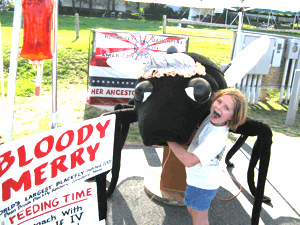
Bloody Merry and a fan at the Machais Blueberry Festival. (Photo: Laurie Sanders)
[SOUND OF DOOR OPENING]
SANDERS: Stepping inside her house, she points out the blackfly village she built, a collection of miniature, hand-painted, wooden buildings.
DOWLING: Here we have the Blackfly Riverside Motel. Clean running water. Cable TV. Continental breakfast, which is tourists. This is a condo unit. And here’s the Blackfly Bloodbank and Trust, with the fly-up teller.
SANDERS: Dowling has also designer T-shirts, bumper stickers, magnets and coffee cups with slogans like Save the Blackfly, We breed’em, you feed’em, and Fatten, Don’t Flatten. All of this is for sale, but not to raise money for the association. Holly Garner Jackson says, in the last decade, the association has donated more than $40,000 to a variety of charities.

Marilyn Dowling and her housemate, Bloody Merry
(Photo: Laurie Sanders)
JACKSON: We’ve given to the Quoddy Regional Land Trust. We’ve given to the Great Auk Land Trust.
SANDERS: The Blackfly Breeders Association has also made gifts to area libraries. Animal shelters, food pantries and many others.
JACKSON: We do where we can. We’re trying to keep it local, because Washington County is where we live, and where we breed blackflies, and where they pollinate the blueberries. So we’re giving back to the community, that has supported us, and we laugh with them, and they laugh with us.
SANDERS: And one reason they laugh is because of Bloody Merry. That’s M-E-R-R-Y, and right now, she’s resting up, on Dowling’s couch.
DOWLING: Yeah, it’s hard to miss her. Kind of like the elephant in the living room, right. Only it’s a blackfly and she’s 9 feet long. She takes up the whole couch. I built her in the living room one winter. Some people say, ‘your winters are way too long.’
.gif)
Holly Garner Jackson and Marilyn Dowling all sorts of blackfly memorabilia at the MBBA's "secret" headquarters in Machias, ME.
(Photo: Laurie Sanders)
SANDERS: Dowling built her four years ago out of local and recycled materials. And Merry is a work of art. A favorite at parades and conferences. And she’s mechanized.
DOWLING: Bloody Merry, don’t panic. We’re just going to move you.
[SOUND OF GIANT BLACKFLY BEING MOVED)
SANDERS: We clear away the furniture, and shift her to her pedestal.
DOWLING: You should stand back, or you’re gonna get hit by a wing.
[SOUND OF FLAPPING]
SANDERS: Dowling plugs her in, and Merry starts flapping away.
DOWLING: Oh there she goes. A lot of children just love her and they just run up and give her a big hug. I think she’s doing a lot for public relations between humans and blackflies.
SANDERS: Bloody Merry will be making several appearances at festivals around Maine this summer. For Living on Earth, I’m Laurie Sanders. And, may the swarm be with you.
Related link:
Maine Blackfly Breeder's Association
[MUSIC] Peter Narvaez “Black Fly Moan” from Some Good Blues (Rowdyblues 2002).
Music With a Solar Flare

Astrophysicists predict that we will soon enter a period of unusually active solar flare activity. (Wikicommons)
YOUNG: Most of us look to the sun as our source of light and heat. But Robertus von Fáy-Siebenbürgen looks at the sun and hears music. He’s head of the solar physics team at the UK’s University of Sheffield, and has captured the magnetic vibrations of the sun’s corona and turned them into a sound. Listen:
[SOUND OF THE SUN]
YOUNG: So, professor, what are we hearing here?
VON FÁY-SIEBENBÜRGEN: This is awesome isn’t it? Yes I think the way to imagine this is that, imagine that you have a football and on the surface of the ball there would be little spikes. Now these little spikes, that are also on the sun, are made of magnetic field lines, you know magnetic field lines do not go into infinity like electric field lines, so they always are closed. They are like strings, like guitar strings, so it has a beginning and then an end. And, what you have here is the observation of these oscillations and the frequency is then transformed into the frequency of the human ear.
[SUN SOUNDS]
YOUNG: How does turning the data into sound help you better understand this?
VON FÁY-SIEBENBÜRGEN: Right. If you have a kidney stone, these days you’re not going to have an operation. What will happen, you go to the doctor, he’s using a sonic device, he launched a sound wave and your kidney reflects the sound wave, and there’s a smart device, which turns the reflected sound into an image, and the doctor can see in side your body. We can’t go into the sun or we can’t even go into the atmosphere of the sun, so what we do, we try to find in nature, a phenomenon which will generate oscillations or waves. We observe these reflected waves, we analyze these reflected waves, and then that’s the way we try to look into a star, or we try to look into the feature of the star.
YOUNG: So, when you’re hearing that, with your very practiced ear on this, what do you hear?
ROBERTUS: Noise.
[MUSIC]
ROBERTUS: No it’s not really noise it’s actually a beautiful music. Can I just give you another example? A very simple one that people can understand. You know when you go to the railway station, very often you see a gentleman having a hammer in his hand and he goes along the train and he hits the wheel of the train—
YOUNG: Kind of pinging them, yes.
ROBERTUS: Yeah. What he’s doing, we are doing exactly the same. This gentleman hits the wheel, and then he listens to the response of the wheel and if there’s a little crack he is able to identify with his ear, that the response, you know, the tone, the pitch, is different.
YOUNG: Right, it’s going to buzz a little and he knows something’s bad, yeah.
ROBERTUS: We do exactly the same. We know what frequencies they should have, and what we detect, what we hear, is different from what we would expect and then these differences are what is telling us information about the structure, or for instance, the internal structure of a star or the internal structure of one of those magnetic features in the atmosphere of the star. So this is the technique we are using.
YOUNG: You know, I’ve read that we are entering a period of very irregular activity with sunspots.
ROBERTUS: Absolutely correct.

Astrophysicists predict that we will soon enter a period of unusually active solar flare activity. (Wikicommons)
YOUNG: Will that show up in the measurements that you’re taking here, will it change the tune that the corona is singing to you?
ROBERTUS: Yes, absolutely. So usually there is an 11-year cycle. Now what has happened, the last cycle there was a very long silent mode of the sun. There was very little activity, and what has happened this year, the activity has started to pick up and the prediction is that in 2012 or 2013 we may have one of the strongest activities that we have seen. And that bring us to another extremely interesting question. I would like to remind everyone that in 1859 there was a very strong solar activity, a solar eruption. Now if that solar eruption would have happened now, these days, that would have an absolutely serious consequence on life on earth because it would kick out our electric system.
YOUNG: Wow. What kinds of consequences can we expect from the upcoming activity then?
ROBERTUS: Well, very likely something will happen with strong activity. Now, what we should do, we should just observe the sun very carefully and try to predict these huge eruptions, and when the eruption happens we should try to shut down our electric system at least for a couple of hours so that the electric system is not damaged.
YOUNG: So going back to the fact that you’ve taken this data and put it in audible form, did it strike you that this has potential for music?
ROBERTUS: Uh, well you know. What is music? Music is very relative, isn’t it?
YOUNG; It’s in the ear of the beholder, I guess, yes.
ROBERTUS: Some people call music what Eminem plays, some people call music what ABBA plays (laughs), but, you know, I’m sure that if I show my grandmother Eminem she will say this is noise. (Laughs). So in a sense, what is music? It has a very wide range of interpretation. What we hear is music because there is some harmonies in it, if you like; there is some periodicity, but the truth, is that this is more or less like noise.
[SUN SOUND]
YOUNG: Robertus von Fáy-Siebenbürgen at University of Suffix England’s Solar Physics and Space Plasma Research Center. Thank you very much.
ROBERTUS: I thank you.
Related link:
Read more about the solar symphony from the University of Sheffield
[MUSIC] Various Artists “Breathe (Pink Floyd) from Rewind (Ubiquity Records).
YOUNG: Living on Earth is produced by the World Media Foundation. Our crew includes Bobby Bascomb, Eileen Bolinsky, Bruce Gellerman, Ingrid Lobet, Helen Palmer, Jessica Ilyse Smith, Ike Sriskandarajah, and Mitra Taj, with help from Sarah Calkins, and Sammy Sousa. Our interns are Amanda Martinez and Meghan Miner. Jeff Turton is our technical director. Alison Lirish Dean composed our themes. Steve Curwood is our executive producer. You can find us anytime at LOE dot org – and check out our Facebook page – it’s PRI’s Living on Earth. I’m Jeff Young. Thanks for listening.
ANNOUNCER 1:Funding for Living On Earth comes from the National Science Foundation supporting coverage of emerging science. And Stonyfield farm, organic yogurt and smoothies. Stonyfield pays its farmers not to use artificial growth hormones on their cows. Details at Stonyfield dot com. Support also comes from you, our listeners. The Ford Foundation, The Town Creek Foundation, The Oak Foundation supporting coverage of climate change and marine issues. And Pax World Mutual Funds, integrating environmental, social, and governance factors into investment analysis and decision making. On the web at Pax world dot com. Pax World for tomorrow.
ANNOUNCER 2: PRI- Public Radio International
Living on Earth wants to hear from you!
Living on Earth
62 Calef Highway, Suite 212
Lee, NH 03861
Telephone: 617-287-4121
E-mail: comments@loe.org
Newsletter [Click here]
Donate to Living on Earth!
Living on Earth is an independent media program and relies entirely on contributions from listeners and institutions supporting public service. Please donate now to preserve an independent environmental voice.
NewsletterLiving on Earth offers a weekly delivery of the show's rundown to your mailbox. Sign up for our newsletter today!
 Sailors For The Sea: Be the change you want to sea.
Sailors For The Sea: Be the change you want to sea.
 The Grantham Foundation for the Protection of the Environment: Committed to protecting and improving the health of the global environment.
The Grantham Foundation for the Protection of the Environment: Committed to protecting and improving the health of the global environment.
 Contribute to Living on Earth and receive, as our gift to you, an archival print of one of Mark Seth Lender's extraordinary wildlife photographs. Follow the link to see Mark's current collection of photographs.
Contribute to Living on Earth and receive, as our gift to you, an archival print of one of Mark Seth Lender's extraordinary wildlife photographs. Follow the link to see Mark's current collection of photographs.
 Buy a signed copy of Mark Seth Lender's book Smeagull the Seagull & support Living on Earth
Buy a signed copy of Mark Seth Lender's book Smeagull the Seagull & support Living on Earth

